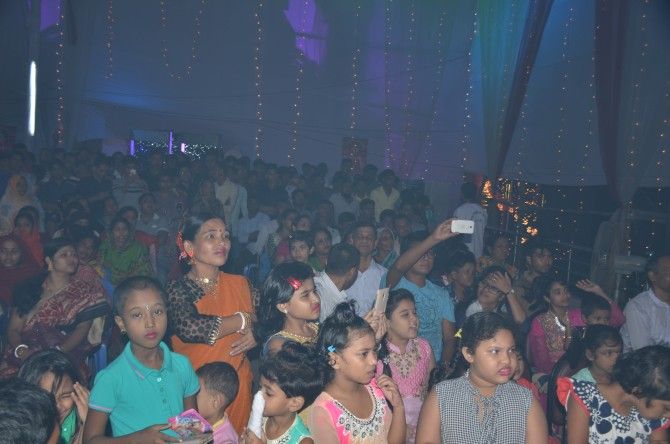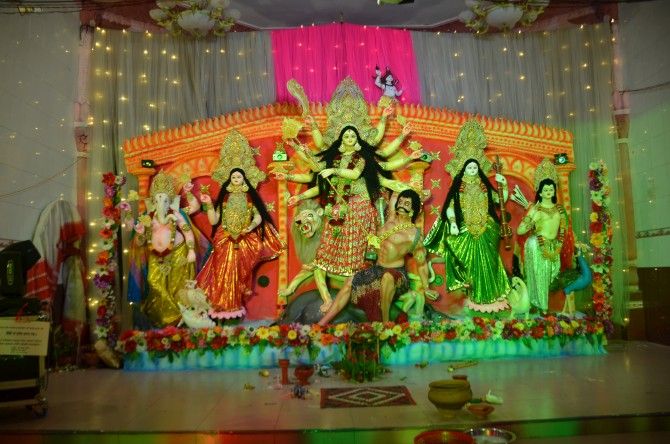‘In all the Puja mandaps I saw a large number of Hindu families in traditional attire, and Muslims too -- men and women coming in with reverence.’
‘A renowned Puja singer, Zeenat Jahan, captivated the audience with her beautiful rendition of Ma Durga songs, and intermittently she would say, Bolo Durga Mai Ki! and the audience will reply in a thundering voice, Jai!’
Tarun Vijay visits 20 Durga Puja pandals in five towns in Bangladesh and comes back impressed.
Illustration: Dominic Xavier/Rediff.com.

Photograph: / Rediff.com
It was 8.30 am on September 26, when I spoke to my mashima (aunt) in Kolkata about Durga Puja -- only to be told she was on her way to Barisal, near Khulna (once a Jamaat e Islami hotbed), in Bangladesh, to join the Durga Puja celebrations.
Almost in the same breath I said, wait, I am also coming along, would love to see how Hindus celebrate Puja in a Muslim country where the State religion is Islam.

She took it as a joke, but I was serious and immediately requested Bangladesh's suave and friendly High Commissioner Syed Muazzem Ali in Delhi for a visa soonest, to take the evening flight to Kolkata and then to cross the border by road early the next morning.
The journey was virtually like getting happily rain-soaked on a hot summer day. Like hotat ma daklen, chhele chhute mar kachhe gelam (when the mother calls suddenly the son runs to her), without second thoughts I was on the last flight to Kolkata and landed there at 1.30 am.

But even at that early hour Kolkata was wide awake, the roads were packed with Puja crowds, with men, women and kids everywhere. Some Puja pandals, like the Bahubali-themed one, had such long lines that my driver’s cousin stood in queue for three hours.
Mother’s divine power binds everyone in one thread of fraternity, and seeing the number of women devotees on the streets, I felt that Kolkata was safer for women than many other cities.

The only irritant was the huge cutouts of Chief Minister Mamata Banerjee before the pandals. Why do they want to use devotees’ attention for political benefit in a religious celebration? That too when she has earned the ill-will of Hindus by stopping Puja visarjan to facilitate Moharram procession? Any day, Bangladesh, otherwise known for the anti-Hindu attitude of its diehard mullahs, did better than a state run by a Hindu Brahmin CM. What an irony!

By 3.30 am the next day I reached my ATM (Any Time Madad) Shreyansh’s home, had a quick shower and we left for Petrapole, the border post 80 km from the city.
Reaching the Petrapole-Benapole border checkpoint came as an introduction to Bengal’s sorry infrastructure development saga. The 95-km journey on a bumpy, potholed road took three-and-a-half hours, that too in the early hours of the day.

At the end of it, as always it felt good to see the border being manned by our smart, young BSF jawans.
My friends from various Hindu organisations of Bangladesh were only too happy to receive me. It was unusual for them to welcome a non-Bengali, Hindi-speaking person from Uttarakhand, who was coming only to see amader Durga pujo (our Durga Puja), they said.
Crossing the border didn’t feel like having stepped into a foreign land. The people, attire, language, poverty, chaotic bad roads and shops wore the same look as they did on our side. But Bengali, and only Bengali, was everywhere, on signboards, vehicle registration plates, road signage, unlike our own Bengal where English language is a sign of ‘progress’.
Our first Durga Puja pandal was at Keralkata Thakur Bari, in Jessore district (though we would reach Jessore town after a 15-hour circuitous Puja drive). It was morning, yet about 50 Hindus were gathered there, the pandal was as simple as a village one could be. Loudspeakers blared Durga saptashati path in Sanskrit and inside the pandal a Bengali priest was distributing prasad to devotees.

The local Hindus, who had gathered to see an Indian Hindu coming from the Himalayas, started talking about how they celebrate Puja and why I must stay for the evening programme when there would be people in much larger numbers. This is one of the most ancient Durga Pujas, and is being held continuously for the last 500 years.
The next six Puja mandaps we visited were at Jhaudanga, Satkhira Mayer Bari, Kochua, Badartala, Parulia, and Nalta. They all were beautifully decorated and reflected the celebratory mood in full swing. It’s a rural belt, and the people are mostly farmers and small traders.
Normally Hindus don’t find a place in government jobs, at least that’s a common complaint. But under Sheikh Hasina some openings have been made for Hindus in the police force, though at a lower level like constables and assistant sub-inspectors. Of course, a number of Hindus are appointed at the secretary level and they are highly respected for their competence.
During Navratras we observe fast but Bengalis love to feast. So they had specially prepared ‘Poddar ilish’ (hilsa from the Padma river, the ultimate 'divine' cuisine) and all those Bengali delicacies one would walk a hundred miles to savour, but alas, me, a north Indian vegetarian, and that too on fast, had to keep myself deprived. And they laughed about it. Dada, khao (have a bite), Ma will not be angry, said Gopal Sarkar. I yielded and had dal-bhaat with lots of lanka (green chillies).

On the move almost continuously, we then reached Kaliganj, followed by Gajirhaat and Bishnupur, and decided to reach Jessore next morning. In all the Puja mandaps I saw a large number of Hindu families in traditional attire, and Muslims too -- men and women coming in with reverence. After all, Bengali Hindus and Muslims are of the same blood, same race, same caste and even share common ancestors. It is only the latter-day Wahhabi influence taken to hateful depths by elements like Jamaat e Islami that has created a gulf, resulting in Hindus' exodus, mayhem and segregation.
When I met Bangladesh’s reputed human rights activist Sheheryar Kabeer in Dhaka, he said that till 2013 it was not possible to hold Durga Puja in Satkhira and many other pockets (the towns I visited the previous evening), and it was only after Sheikh Hasina’s ascendancy to power that the situation has changed in favour of Hindus.
Previous governments were in denial whenever any incident occurred against Hindus, but this government accepts the situation, files a report, but doesn't take action. At least some steps forward, he smiled.
In spite of the joyous celebrations, happy family get-togethers and aesthetically decorated pandals, Hindus do show signs of fear and anxiety. Nobody knows where the next attack would occur and what will be the outcome. After all, a number of incidents of vandalism in Durga pandals have already occurred.
Some of the recent incidents of violence and vandalism have been courageously reported by the Bangladeshi media, but they have also shaken Hindus, as these headlines from various local newspapers show: Girl ‘gang-raped’ in Thakurgaon; 4 idols vandalised at Dinajpur puja pandal; 4 idols of Goddess Durga and others vandalised in Muradnagar; Young Hindu woman abducted by Awami league leader; and, Temple vandalised.
My last stop on this Puja yatra was Dhaka, which was simply fabulous and joyous.
I had been specially invited by the Dhaan Mandi Sarbajaneen Puja Samiti along with Bangladesh Hindu Mahajot president Gobind Pramanik. It had about 20,000 Hindus and Muslims joining the Puja celebrations.

A renowned Puja singer, Zeenat Jahan, captivated the audience with her beautiful rendition of Ma Durga songs, and intermittently she would say, Bolo Durga Mai Ki! and the audience will reply in a thundering voice, Jai!
Of late a huge, classy Durga Puja pandal has been started in the high-security area of Dhaka’s Defence Officers’ Housing Society residential area for high-ranking armed forces personnel. It is headed by a retired brigadier, Pradeep Roy. The various entertainment shows at this Puja were quite awesome, including the traditional Dhunuchi naach.
Ramana Kaali and Dhakeshwari temple puja mandaps were spiritual and had a special aura around them. Dhakeshwari is the presiding deity of Dhaka while Ramana Kaali, an ancient temple, was destroyed during the 1971 war by the Pakistani army and later after the Awami League took over the extremist elements in the party razed it to the ground. Now the temple is being rebuilt to its pristine glory with the Indian government’s help.
There are anxieties and concerns among Hindus. But there are also new openings. The Narendra Modi-Sheikh Hasina chemistry seems to be working to facilitate Hindus in some areas, though Hindus still face hidden and sometimes open resistance.
The present chief justice of the Bangladesh supreme court, Surendra Kumar Sinha, is a Hindu of Manipuri tribal origin, and was appointed not because of any political facilitation but the system helped and the State apparatus didn’t oppose him. Now he is facing a lot of resistance from extremist elements, and there are pressures to make him relinquish the post.
Two years earlier fatwas had been issued by jihadi mullahs against Muslims attending Puja festivities, but after Sheikh Hasina took a bold step and attended Durga Puja, slapping them hard in the process, the result is a large, mushrooming growth of Puja celebrations across the country.
This year alone more than 33,000 Durga Puja mandaps were organised and all of them got financial assistance from the government. As Hasina was travelling abroad during Puja this year, the president, Abdul Hamid, reserved Durga Maha Navami day to receive Puja greetings from Hindus.
From the near-elimination of Bangladesh’s Hindu population -- twice, in 1947 and in 1971 -- that accounted for more than 42% in 1947 and now stands at a bare 10 to 15% (all statistics are contested by pro and anti-Hindu elements), much water has flowed in the Padma.
We are bound by culture, history, joint action for freedom, Mukti Bahini, the Ganga, Padma, Yamuna, Tagore and Kavi Nazrul Islam.
Let the spirit of Durga Puja guide us both to move forward, to realise the dream of Amar Shonar Bangla and Jana Gana Mana Adhinayak, both immortal national anthems created by the icon of our togetherness, Kavi Guru Rabindranath Tagore.
Jai Ma Durga!










